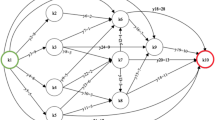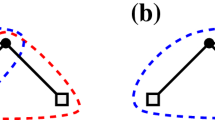Abstract
We consider the problem of interdicting a directed graph by deleting nodes with the goal of minimizing the local edge connectivity of the remaining graph from a given source to a sink. We introduce and study a general downgrading variant of the interdiction problem where the capacity of an arc is a function of the subset of its endpoints that are downgraded, and the goal is to minimize the downgraded capacity of a minimum source-sink cut subject to a node downgrading budget. This models the case when both ends of an arc must be downgraded to remove it, for example. For this generalization, we provide a bicriteria (4, 2)-approximation that downgrades nodes with total weight at most 4 times the budget and provides a solution where the downgraded connectivity from the source to the sink is at most 2 times that in an optimal solution. We accomplish this with an LP relaxation and rounding using a ball-growing algorithm based on the LP values. Furthermore, we show that other bicriteria approximations exist where one can worsen the approximation factor for one of the costs in order to improve the other. We further generalize the downgrading problem to one where each vertex can be downgraded to one of k levels, and the arc capacities are functions of the pairs of levels to which its ends are downgraded. We generalize our LP rounding to get a (4k, 4k)-approximation for this case. Trade-offs between the two approximation ratios similar to the two-level case also exist for the generalized problem. By transferring node values to edge values, we also derive new bicriteria approximation results for the vertex interdiction versions of the multiway cut problem in digraphs and multicut problems in undirected graphs.




Similar content being viewed by others
Notes
This is the major difference compared to NVDP where we no longer need to add dummy arcs nor rescale the weights \(x^*\). The relevant arcs in \(H'\) for NVDP forms a subdivision of a star. After deleting all the backward arcs, it no longer remains as a star but could have disconnected arcs. Then, the range of these arcs is no longer bounded around (vv) and thus needed other modifications.
We can simply try all possible L values using binary search to find the smallest value for which the condition holds. To make this search polynomial time, we can simply search over multiplicative powers of \((1 + \epsilon ')\) for some small \(\epsilon ' > 0\) starting from 1 and up to the maximum possible cost of a cut using \(\log _{1 + \epsilon '} {mc_{max}}\) trials where m is the number of arcs and \(c_{max}\) is the largest arc cost.
References
Agarwal, A., Alon, N., Charikar, M.S.: Improved approximation for directed cut problems. In: Proceedings of the Thirty-Ninth Annual ACM Symposium on Theory of Computing. ACM, pp. 671–680 (2007)
Bhaskara, A., Charikar, M., Chlamtac, E., Feige, U., Vijayaraghavan, A.: Detecting high log-densities: an \({\cal{O}} (n^{\frac{1}{4}}\)) approximation for densest k-subgraph. In: Proceedings of the Forty-Second ACM Symposium on Theory of Computing. ACM, pp. 201–210 (2010)
Burch, C., Carr, R., Krumke, S., Marathe, M., Phillips, C., Sundberg, E.: A decomposition-based pseudoapproximation algorithm for network flow inhibition. In: Woodruff, D.L. (ed.) Network Interdiction and Stochastic Integer Programming, vol. 26, pp. 51–68. Springer, Berlin (2003)
Călinescu, G., Karloff, H., Rabani, Y.: An improved approximation algorithm for multiway cut. J. Comput. Syst. Sci. 60(3), 564–574 (2000)
Chekuri, C., Madan, V.: Simple and fast rounding algorithms for directed and node-weighted multiway cut. In: Proceedings of the Twenty-Seventh Annual ACM-SIAM Symposium on Discrete Algorithms. SIAM, pp. 797–807 (2016)
Chestnut, S.R., Zenklusen, R.: Interdicting structured combinatorial optimization problems with \(\{\)0, 1\(\}\)-objectives. Math. Oper. Res. 42(1), 144–166 (2016)
Chestnut, S.R., Zenklusen, R.: Hardness and approximation for network flow interdiction. Networks 69(4), 378–387 (2017)
Chuzhoy, J., Makarychev, Y., Vijayaraghavan, A., Zhou, Y.: Approximation algorithms and hardness of the k-route cut problem. ACM Trans. Algorithms (TALG) 12(1), 2 (2016)
Chuzoy, J.: Flows, cuts and integral routing in graphs—an approximation algorithmist’s perspective. In: Proceedings of of the International Congress of Mathematicians
Feige, U.: Relations between average case complexity and approximation complexity. In: Proceedings of the Thirty-Fourth Annual ACM Symposium on Theory of Computing. ACM, pp. 534–543 (2002)
Garg, N., Vazirani, V.V., Yannakakis, M.: Approximate max-flow min-(multi) cut theorems and their applications. SIAM J. Comput. 25(2), 235–251 (1996)
Garg, N., Vazirani, V.V., Yannakakis, M.: Multiway cuts in node weighted graphs. J. Algorithms 50(1), 49–61 (2004)
Golden, B.: A problem in network interdiction. Naval Res. Log. Q. 25(4), 711–713 (1978)
Guenin, B., Könemann, J., Tuncel, L.: A Gentle Introduction to Optimization. Cambridge University Press, Cambridge (2014)
Gupta, A., O’Donnell, R.: Lecture 18 on Multicuts. Lecture Notes for 15-854(B): Advanced Approximation Algorithms, Spring (2008)
Guruganesh, G., Sanita, L., Swamy, C.: Improved region-growing and combinatorial algorithms for k-route cut problems. In: Proceedings of the Twenty-Sixth Annual ACM-SIAM Symposium on Discrete Algorithms. Society for Industrial and Applied Mathematics, pp. 676–695 (2015)
Harris, T.E., Ross, F.S.: Fundamentals of a method for evaluating rail net capacities. Technical report, Santa Monica, California (1955)
Israeli, E., Wood, R.K.: Shortest-path network interdiction. Netw. Int. J. 40(2), 97–111 (2002)
Khot, S.: Ruling out PTAS for graph min-bisection, dense k-subgraph, and bipartite clique. SIAM J. Comput. 36(4), 1025–1071 (2006)
Linhares, A., Swamy, C.: Improved algorithms for MST and metric-tsp interdiction. In: Proceedings of 44th International Colloquium on Automata, Languages, and Programming, vol. 32, pp. 1–14 (2017)
Naor, J., Zosin, L.: A 2-approximation algorithm for the directed multiway cut problem. SIAM J. Comput. 31(2), 477–482 (2001)
Papadimitriou, C.H., Yannakakis, M.: On the approximability of trade-offs and optimal access of web sources. In: Proceedings 41st Annual Symposium on Foundations of Computer Science. IEEE, pp. 86–92 (2000)
Phillips, C.A.: The network inhibition problem. In: Proceedings of the Twenty-Fifth Annual ACM Symposium on Theory of Computing, STOC’93, New York, NY, USA. ACM, pp. 776–785 (1993)
Schrijver, A.: On the history of the transportation and maximum flow problems. Math. Program. 91(3), 437–445 (2002)
Sharma, A., Vondrák, J.: Multiway cut, pairwise realizable distributions, and descending thresholds. In: STOC (2014)
Wood, R.: Deterministic network interdiction. Math. Comput. Model. 17(2), 1–18 (1993)
Zenklusen, R.: Matching interdiction. Discrete Appl. Math. 145(15), (2010)
Zenklusen, R.: Network flow interdiction on planar graphs. Discrete Appl. Math. 158(13), (2010)
Zenklusen, R.: Connectivity interdiction. Oper. Res. Lett. 42(67), 450–454 (2014)
Zenklusen, R.: An \(\cal{O} (1)\) approximation for minimum spanning tree interdiction. In: Proceedings of 56th Annual IEEE Symposium on Foundations of Computer Science, pp. 709–728 (2015)
Acknowledgements
We thank the two anonymous reviewers whose comments/suggestions helped improve and clarify this manuscript. We especially thank an anonymous reviewer for pointing out the reduction given in Sect. 3.2.
Author information
Authors and Affiliations
Corresponding author
Additional information
Publisher's Note
Springer Nature remains neutral with regard to jurisdictional claims in published maps and institutional affiliations.
An extended abstract of this paper appeared in the 17th Scandinavian Symposium and Workshops on Algorithm Theory (SWAT 2020)
This material is based upon work supported in part by the U. S. Office of Naval Research under Award Number N00014-21-1-2243 (N00014-18-1-2099) and the Air Force Office of Scientific Research under Award Number FA9550-20-1-0080.
Rights and permissions
About this article
Cite this article
Aissi, H., Chen, D.Q. & Ravi, R. Vertex downgrading to minimize connectivity. Math. Program. 199, 215–249 (2023). https://doi.org/10.1007/s10107-022-01824-5
Received:
Accepted:
Published:
Issue Date:
DOI: https://doi.org/10.1007/s10107-022-01824-5




